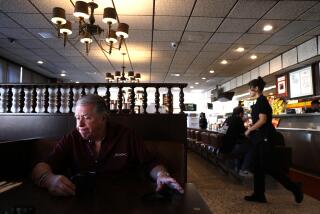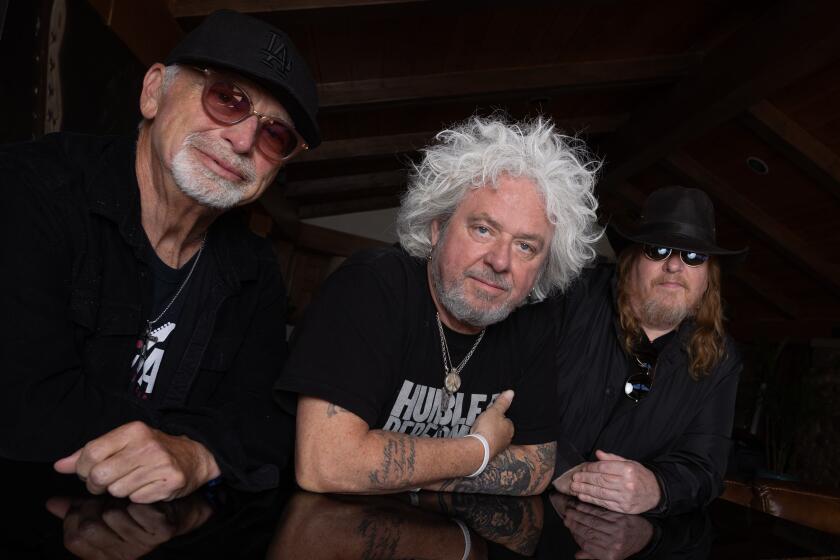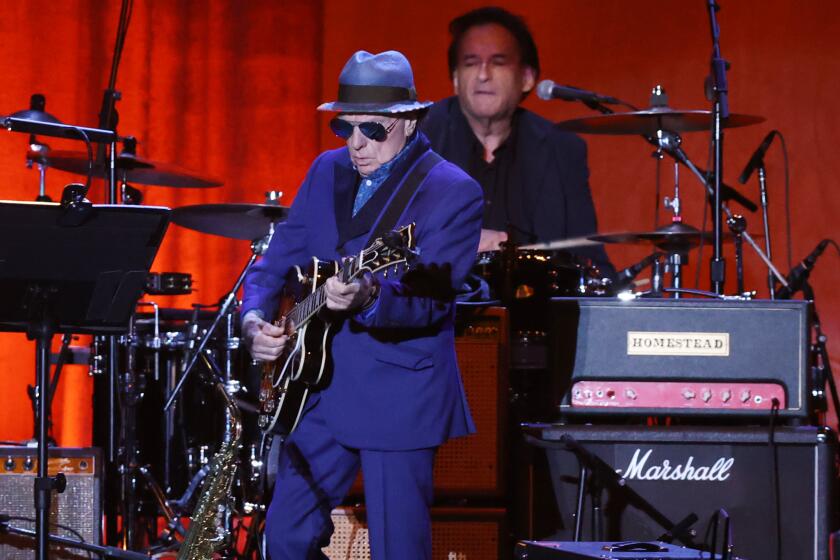Jazz Gives La Jolla Soul in Out-of-the-Way Niche : SAN DIEGO COUNTY
LA JOLLA — If your timing’s right, you can stroll along a back street here and hear a free concert by a world-renowned jazzman.
Like the customer who walked into a Draper Avenue tennis shop and asked about the lazy strains of a saxophone spilling out from the living room of a nearby bungalow.
“I told him it was just Charles McPherson, winding up his daily practice session,” recalled Mark Standlee, owner of the Racket Stringing Workshop. “He apparently knew something about jazz, because he just smiled and said it sure sounded like McPherson.”
In international jazz circles, Charles McPherson is something of a celebrity, an alto saxophonist who has played professionally for three decades, touring with the likes of bassist Charles Mingus and releasing more than 25 albums of his own.
But on Draper Avenue, McPherson is just Charles, the guy who practices every day in the little house with the white picket fence--one of two bungalows his family has owned on the block for the past 50 years.
McPherson isn’t the only one making music on Draper Avenue these days. He’s among a cadre of jazz musicians who populate a tiny, two-block neighborhood between Pearl and Prospect streets that’s becoming known to locals and music fans alike as Jazz Alley.
Treble Clef Wind Chimes
On the same block as McPherson’s studio, where wind chimes shaped like treble clefs dangle above the front door, there’s a duplex with an aged piano wedged into the tiny living room.
That’s where tenor saxophonist Joe Marillo lives with his girlfriend, Susan Rathfon, a classical pianist, and Ray Crawford, a local bass player and music teacher.
In the past few years, more than half a dozen other jazz artists have moved on and off the block. Last year, tenor saxophonist Jimmy McCasey lived in a trailer behind Marillo’s duplex, practicing eight hours a day before rushing off to perform gigs after dark.
“Yeah, there does seem to be a preponderance of jazz music on this block,” the 49-year-old McPherson said recently as he took a break from his playing, propping his gold-plated alto in an overstuffed chair like a revered guest.
“It’s unusual, having all these creative people on one street. But it definitely lends the block some aesthetic character. I just don’t think enough people appreciate it.”
For these jazzmen and many of their neighbors, Draper Avenue is an oasis of music in a town where the sound of money is often the loudest thing heard.
But the spirit of Draper’s jazz is being threatened by the developer’s backhoe. All around this core of artists, the avenue is growing up, changing.
Sixty-year-old houses are being replaced by condominium complexes. A snazzy new branch of the San Diego Public Library opened recently, bringing with it more traffic and people problems to a street that isn’t used to being a thoroughfare.
Suddenly, Draper Avenue, like the rest of La Jolla, is hot property. Since the library opened three months ago, property owners on Draper began receiving unsolicited offers from realtors.
“I’ve had offers of almost a million dollars for these two lots alone,” said McPherson, who lives in North Park but uses the Draper Avenue house as an office and studio. “I mean, the Pacific Ocean is right down the street. If my family didn’t move here in the ‘40s, I wouldn’t even be able to afford to stay in this neighborhood.”
Carrie Tonini, manager of the Jelley Co. real estate firm in La Jolla, said property values on Draper are skyrocketing along with the rest in the area.
“Last year, La Jolla enjoyed a 45% appreciation in single-family houses,” she said. “When you have that kind of appreciation, every piece of property looks real good, no matter where it is.”
Still Cool
Despite the development all around them, the musicians who live and practice there say Draper Avenue is still the coolest place around.
“This is Jazz Alley, there’s no doubt about it,” said Marillo, 50, an accomplished tenor player who has performed in nightclubs throughout San Diego for more than a decade. “There’s some musical energy here. And there’s not too many residential streets anywhere you can say that about.”
The jazz label is only the most recent tag for this colorful stretch of street.
In the 1920s and ‘30s, the neighborhood was known as “Browntown,” the center of a poor, largely black neighborhood, many of whose residents were employed in the mansions of rich, white La Jollans in the old Muirlands area.
A generation later, veteran residents say, the enclave had expanded to surrounding streets, where Mexican and Filipino families rented modest one-bedroom houses.
Back then, Draper Avenue had soul. There was a tiny restaurant called the Bar-B-Q Cafe (with the requisite lively jukebox, three selections for a dime). There were auto accessory shops mixed in with run-down beach houses, and maybe a junkyard here and there.
Shrank to 2 Blocks
As years passed, Draper continued to shed its skin. A veterinary hospital moved in. The barbecue restaurant became Standlee’s tennis shop.
The neighborhood, which once spread across southern La Jolla, shrank to just two blocks.
Still, Draper Avenue could not shake its image as a main artery of La Jolla’s ghetto, a street where shabby apartments changed hands regularly and police patrol cars paid visits all too often.
Today, problems still exist. Marillo recently opened his front door to see a shooting victim writhing on the sidewalk. He called police, but the man died on the spot.
But such is city life, he says--even in La Jolla.
Marillo moved to Draper Avenue six years ago when his then-wife took a job at a restaurant around the corner. When the marriage broke up, Marillo stayed put.
Bagel and a Beer
He feels as free there as when he’s playing languid riffs on the saxophone. From his house, he can walk to his job as an instructor at a nearby music store, buy a bagel and a beer, do his laundry, go to the beach--all without getting in his car.
“This street is probably one of the best places in the country to live,” he said. He sits on the piano stool in his living room wearing a pair of blue jeans, no shirt. A portrait of saxophone great Sonny Rollins hangs on the wall nearby.
“If someone gave me a house anywhere else, someplace inland, I’d rent it out rather than live there. I couldn’t live anywhere else. If Sonny Rollins lived in La Jolla, he’d live on Draper Avenue, too.”
McPherson, who moved to San Diego from New York 10 years ago, soon discovered that Draper Avenue had a crazy beat.
“The first week I was here, I met these guys who were playing freestyle jazz in their apartment during the day,” he recalled. “We jammed together all the time, in the afternoons and on Saturdays.”
One night, McPherson walked over to nearby Chuck’s Steak House on Prospect Street, where Marillo was playing.
Friends and Collaborators
“He was wearing this long, black coat,” Marillo recalled. “When we finished, he came up to me and said, “Hey, I like the way you play.’ When he told me who he was, I said, ‘Wow! If I’d have known you were in the audience, I wouldn’t have been able to play at all.”
The two became friends. Before long, they were collaborating.
“When Joe is writing a song, he might want to know how things sound. And he can’t play the saxophone and the piano at the same time. So I’ll play the sax part for him,” McPherson said.
“Or I might get a new mouthpiece and want to know how it sounds without me playing it. We use each other for a lot of different reasons.”
For Marillo, the collaborations are like a breath of fresh air. “Having Charles right down the street is like being back in school, knowing that the teacher is right there to give you an answer.”
McPherson, who grew up in Detroit, still does international performing tours. When he’s in town, he spends several hours a day at the Draper studio practicing, or “woodshedding,” as fellow musicians call it.
Varied Reactions
The music has brought varied reactions.
“I’ve made a point to serenade people because I saw them standing outside the house listening to me,” he said. “Some will knock on the door and ask who I am and where they can hear me play.”
But not everyone.
“One teen-ager stopped and scowled when she heard me play,” McPherson said. “If I had been playing Van Halen, she probably would have liked it. But the music was jazz. So she yelled out some ugly comment about me making too much noise.”
Mark Roberts, who works in Standlee’s tennis shop, often hears the music as he restrings rackets.
“You hear Charles playing every now and then when the wind is right,” he said. “I’ve heard him play in clubs in Europe. He’s something of a god over there. Here, many people walk right on by like they don’t even hear him.
“It’s just sad there isn’t any interest in the music here. After all, it’s an American art form.”
He Plays Anyway
Marillo, who teaches saxophone and piano lessons at home, has also heard the heckling. Not from passers-by, but from his landlord.
“I can’t play the piano during the day. She complains if I don’t close the windows,” he said. “But I go ahead and play anyway. I mean, with all the parties and the loud radios . . . this is nicer. This is jazz.”
And this is the spirit of jazz on Draper Avenue: Two years ago, Jimmy McCasey lost his job. His girlfriend left him the same week his mother died. So he called his saxophone teacher, Joe Marillo, for help.
“I had no place to live, no job, nothing. I just had my horn,” he recalled. “Joe offered a trailer for me to live in. He reached out and turned my life around.”
McCasey, who lived in the trailer for a year before moving away, misses the musical vibrations he found along Draper Avenue.
“Joe was living with two other musicians. Charles McPherson was right down the street,” he said. “With all these bad cats around, who could think of a better place to hang? It was like heaven.”
And so the beat goes on along Draper Avenue. Marillo fears that rising property values will only bring more developers, who will force out the remaining rental properties.
“There’s really no reason I’ll leave here,” said McPherson. “It’s not seedy, it’s nice. There’s just something about this street that takes what’s good about La Jolla and puts it to music, so to speak.”
In fact, McPherson says he may one day write a song about his little stretch of creative paradise. “Maybe I’ll call it the Draper Avenue Blues.”
Then he stopped a moment, reconsidering. “Nah, it wouldn’t be a blues number. Too many good things happen here. It’d have to be more upbeat, maybe something with a little salsa rhythm to it.”
* MORE SAN DIEGO JAZZ
San Diego musicians stage a reunion. Calendar.
More to Read
The biggest entertainment stories
Get our big stories about Hollywood, film, television, music, arts, culture and more right in your inbox as soon as they publish.
You may occasionally receive promotional content from the Los Angeles Times.











